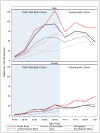Cancer Site-Specific Disparities in New York, Including the 1945-1965 Birth Cohort's Impact on Liver Cancer Patterns
- PMID: 30026296
- PMCID: PMC6193556
- DOI: 10.1158/1055-9965.EPI-18-0194
Cancer Site-Specific Disparities in New York, Including the 1945-1965 Birth Cohort's Impact on Liver Cancer Patterns
Abstract
Background: Analyses of cancer patterns by detailed racial/ethnic groups in the Northeastern United States are outdated.Methods: Using 2008-2014 death data from the populous and diverse New York State, mortality rates and regression-derived ratios with corresponding 95% confidence intervals (CIs) were computed to compare Hispanic, non-Hispanic white (NHW), non-Hispanic black (NHB), Asian populations, and specific Hispanic and NHB subgroups: Puerto Rican, Dominican, South American, Central American, U.S.-born black, and Caribbean-born black. Special analyses on liver cancer mortality, given the higher prevalence of hepatitis C infection among the 1945-1965 birth cohort, were performed.Results: A total of 244,238 cancer-related deaths were analyzed. Mortality rates were highest for U.S.-born blacks and lowest for South Americans and Asians. Minority groups had higher mortality from liver and stomach cancer than NHWs; Hispanics and NHBs also had higher mortality from cervical and prostate cancers. Excess liver cancer mortality among Puerto Rican and U.S.-born black men was observed, particularly for the 1945-1965 birth cohort, with mortality rate ratios of 4.27 (95% CI, 3.82-4.78) and 3.81 (95% CI, 3.45-4.20), respectively.Conclusions: U.S.-born blacks and Puerto Ricans, who share a common disadvantaged socioeconomic profile, bear a disproportionate burden for many cancers, including liver cancer among baby boomers. The relatively favorable cancer profile for Caribbean-born blacks contrasts with their U.S.-born black counterparts, implying that race per se is not an inevitable determinant of higher mortality among NHBs.Impact: Disaggregation by detailed Hispanic and black subgroups in U.S. cancer studies enlightens our understanding of the epidemiology of cancer and is fundamental for cancer prevention and control efforts. Cancer Epidemiol Biomarkers Prev; 27(8); 917-27. ©2018 AACR.
©2018 American Association for Cancer Research.
Conflict of interest statement
Figures

References
-
- US Census Bureau. [Accessed November 2017];Quick Facts New York. Available at: https://www.census.gov/quickfacts/NY.
-
- Siegel RL, Miller KD, Jemal A. Cancer statistics, 2017. CA: a cancer journal for clinicians. 2017;67(1):7–30. - PubMed
-
- Colby SL, Ortman JM. Projections of the Size and Composition of the US Population: 2014 to 2060. Washington, DC: US Department of Commerce, Economics and Statistics Administration, US Census Bureau; Mar, 2015. Report No. P25–1143.
-
- Pinheiro PS, Sherman RL, Trapido EJ, et al. Cancer incidence in first generation U.S. Hispanics: Cubans, Mexicans, Puerto Ricans, and new Latinos. Cancer Epidemiol Biomarkers Prev. 2009;18(8):2162–9. - PubMed
Publication types
MeSH terms
Grants and funding
LinkOut - more resources
Full Text Sources
Other Literature Sources
Medical

